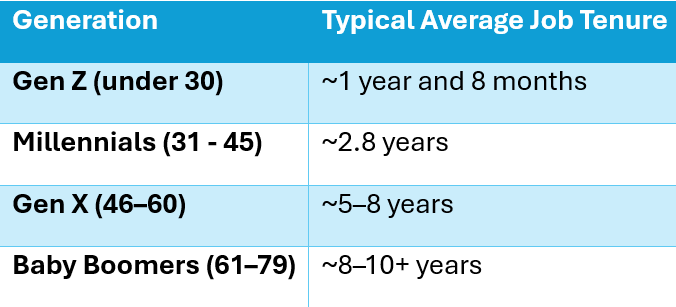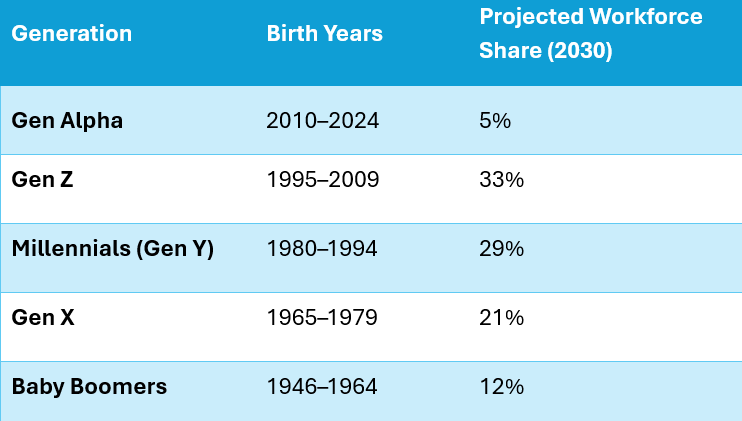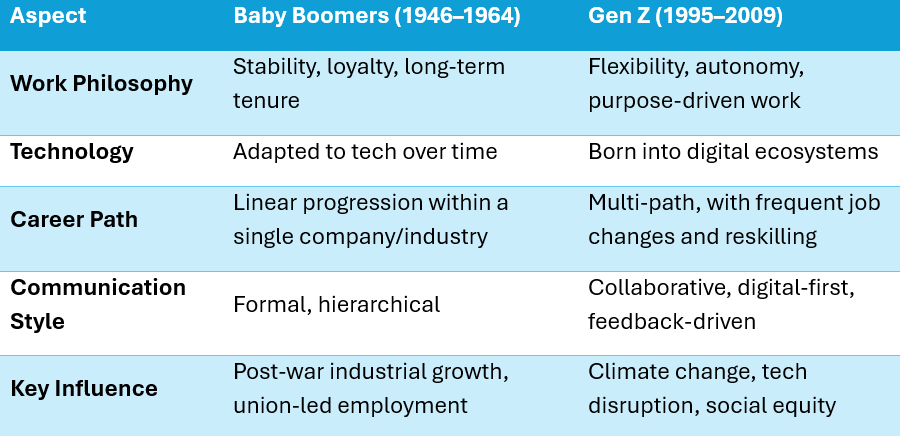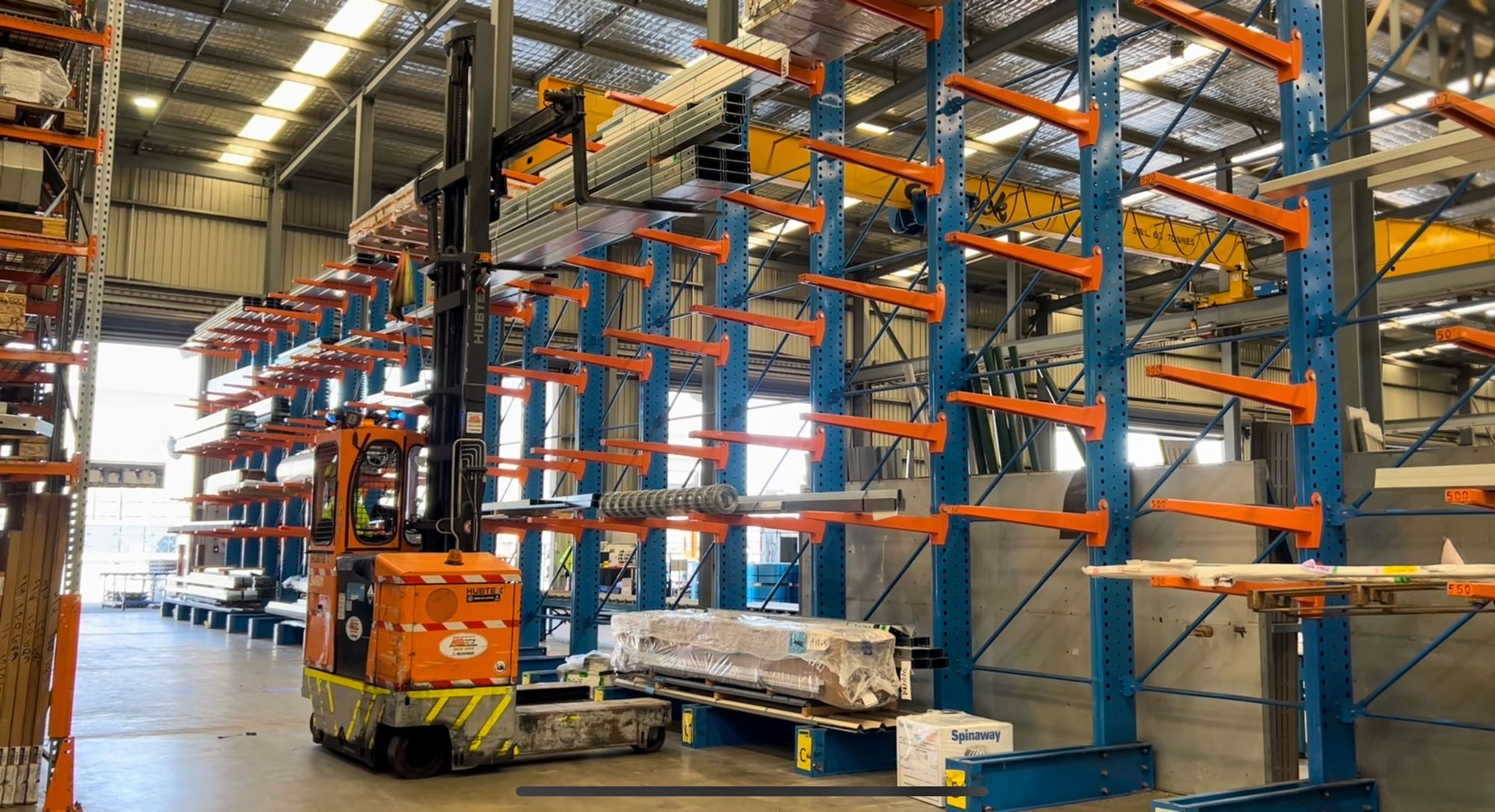Transitioning to the Gen Z Workplace of the Future
We can resist it or embrace it, either way Gen Z is reshaping workplaces. This generation of employees will change how Australian workplaces function, influencing shifts in work preferences, technology and workplace culture.
A Generational Tidal Shift
Like Baby Boomers reshaped Australia through industrial growth, home ownership, and unionised workforces, Gen Z is poised to lead a revolution in workplace design, technology adoption, and employer accountability.
But unlike the industrial era transformation, Gen Z’s impact is being driven by tech, climate action, and human-centred design, and it's rapidly unfolding.
As of 2025, Generation Z (born between 1995 and 2009) constitutes approximately 27% of Australia's workforce. Projections indicate that by 2030, this figure will rise to 33%, making Gen Z the largest generational cohort in the Australian workforce. This anticipated shift underscores the growing influence of Gen Z in shaping workplace dynamics, including preferences for flexibility, digital integration, and values-driven employment.
Projected Workforce Composition in Australia by 2030
Scale and Timing
By 2030, Gen Z will make up one-third of the Australian workforce, just as Baby Boomers did at their peak in the 1970's and 80's. Their size alone will bring about significant changes to how current workplaces function.
Digital Fluency
Gen Z are true digital natives. Their expectation of seamless tech integration, instant communication, and remote collaboration is already driving modernisation of outdated systems and processes.
Value-Centric Decisions
Where Boomers often stayed loyal to one employer, Gen Z is loyal to values. So, the way to engage and retain Gen Z is by prioritising social, environmental and wellbeing initiatives.
Work-Life Fluidity
Gen Z will likely normalise blended working lives — side hustles, gig work, freelance, and project-based employment — challenging the idea of full-time permanency that defined the Boomer era.
Will Average Job Tenure Decline as More Gen Z Employees Enter the Workforce?
In Australia, Gen Z’s average job tenure of 1 year and 8 months is significantly shorter compared to other generations. However, Gen Z are still young, most under 30 and typically it might be expected that job tenure will be short in the formative years of employment.

Are Younger Employees Unrealistic or Do Employers Need to Change?
This short YouTube video takes a light-hearted look at interviewing the younger generations of Gen Z and Millennials. Of course, it’s an extreme representation of employees who are emerging as the dominate generation, but it does highlight the significant gap in expectations. The interviewer describes what the job involves, which is entirely reasonable and consistent with his Baby Boomer generation. On the other hand, the reaction by the young candidate to those duties and expectations comes as a bad surprise, which she finds intolerable and almost offensive.
Embracing Gen Z
Gen Z are coming through with a unique set of skills and will offer great potential and value to organisations.
To maximise performance from Gen Z employees, employers should adapt their workplace practices and operations to align more closely with Gen Z’s values, behaviours, and expectations. This generation is purpose-driven, digitally fluent, and values flexibility and development over tradition and hierarchy.
7 Ways to Prevent Gen Z from Job Hopping
The research on Gen Z is widely available, providing substantial data and analysis of the generational shifts from a range of sources, including Nintex, McCrindle, or The Centre for Work, Organisation & Wellbeing, Griffith University.
There’s an unequivocal and uniform theme which presents detailed social analytics offering employers the keys to transitioning their workplaces. Employers can benefit and gain valuable advantage by embracing these drivers of Gen Z performance and engagement:
1. Flexibility and Autonomy
Gen Z highly values control over when, where, and how they work.
What to implement:
- Flexible start and finish times and remote or hybrid work options.
- Autonomy in task management and workflow, micromanaging is out.
- Results-oriented leadership with a focus on outcomes, not time at a desk.
Example: Look for ways to offer flexible working hours, such as a compressed week (e.g. four 10-hour days). This will boost both engagement and productivity.
2. Purpose and Values Alignment
Gen Z wants to work for organisations that reflect their personal values, especially around sustainability, diversity, and social impact.
What to implement:
- Embed Corporate Social Responsibility (CSR) and Environmental, Social, and Governance (ESG) policies into your strategy.
- Communicate your mission clearly and link individual roles to the bigger picture.
- Engage employees in volunteer or purpose-driven initiatives.
Example: Showcase how your organisation provides meaningful work to disadvantaged groups, aligning with Gen Z’s social justice priorities.
3. Continuous Learning and Development
Career growth and skill development are non-negotiable for Gen Z.
What to implement:
- Offer microlearning, online courses, and supported or mentored stretch assignments.
- Provide access to mentorship and reverse mentoring opportunities.
- Create personalised career progression plans.
Example: Provide developing Gen Z employees access to a self-paced online upskilling platform and organise regular development check-ins with their team leader.
4. Digital-First Tools and Communication
Gen Z is the first generation of true digital natives.
What to implement:
- Use collaboration tools like Slack, MS Teams, or Asana over emails.
- Provide digital onboarding and performance tracking dashboards.
- Encourage short-form video or interactive content for training.
Example: Replace a PDF induction with a mobile-accessible, interactive onboarding app.
5. Feedback and Recognition
Gen Z wants real-time feedback, not just annual reviews.
What to implement:
- Use regular check-ins, short surveys, and performance snapshots.
- Create peer recognition programs.
- Make feedback specific, positive, and actionable.
Example: Use tools like "Shoutouts" or “Wins of the Week” in team meetings to celebrate small achievements.
6. Mental Health and Wellbeing
Wellbeing isn’t a perk; it’s a baseline expectation.
What to implement:
- Offer mental health days and easy access to EAP services.
- Normalise open conversations around stress and mental load.
- Encourage boundary setting (e.g. no weekend emails).
Example: Implement a monthly “Reset Friday” where staff can leave early to recharge.
Read our article "What is a Toxic Work Culture" to avoid your workplace becoming toxic.
7. Inclusivity and Authenticity
Gen Z expects workplaces to be diverse, equitable, and safe for self-expression.
What to implement:
- Train leaders in inclusive leadership practices.
- Support employee resource groups (e.g. LGBTQ+, First Nations).
- Avoid performative diversity, rather back it with policies and action.
Example: Conduct periodic audits of inclusivity practices and invite feedback from Gen Z employees via anonymous platforms.
Summary
Australia’s workforce is undergoing a generational transformation, and Gen Z is at the centre of it. By 2030, they’ll make up one-third of the workforce, surpassing all other generations. And with them comes a fundamental shift in how work is viewed, performed, and valued.
With Gen Z averaging just 1 year and 8 months per job, short tenures may be the new norm, reflecting their priorities around personal growth, mental health, and meaningful work.
Like the Baby Boomers after WWII, Gen Z is reshaping the workplace, but their influence is powered by technology, climate awareness, and a strong desire for purpose, flexibility, and inclusivity. Already, they are driving modernisation in work culture, communication, and employer expectations.
Need support recruiting and retaining the right people across Perth?
Contact IRP
for tailored support across WA’s
key industries.
Join Our Mailing List
Interested in receiving more content similar to this straight to your inbox each month? Sign up to our mailing list below!













